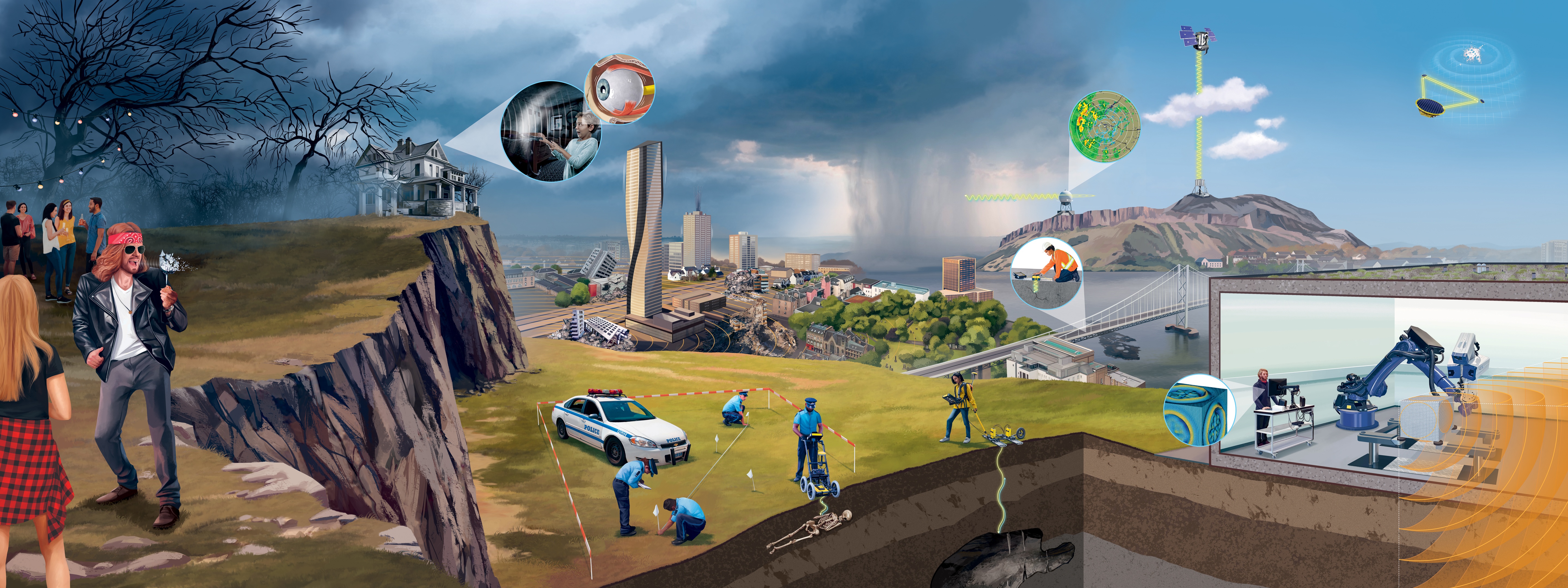Size Matters
Using waves for targeted exploration thanks to different wavelengths
We can use suitable wavelengths in targeted ways to stimulate, detect and investigate objects. The wavelength used
must be on the same scale as the size of the object.

In New Dimensions
Waves convey information. To record them, we need measuring devices that match the respective wavelength. From space, the LISA mission should be able to detect gravitational waves with longer wavelengths than is possible with any of the observatories on Earth. To achieve this, the measuring apparatus will extend over millions of kilometres. LISA could thus allow for the observation of other gravitational wave sources such as the swallowing of a neutron star by a supermassive black hole.
Selecting a suitable wavelength is also important in laboratory experiments. So far, experiments can only use wavelengths that fit into the lab. Hence, for example, earthquake experiments have to mimick the long wavelengths of earthquakes with much shorter wavelengths. Alternatively, experiments can be carried out virtually on a computer. However, neither in the laboratory nor virtually can reality truly be captured.
A new approach combines the advantages of both the laboratory and the computer world: a virtual space is added onto a block of real rock in order for earthquake waves to fit into the experiment. The waves generated in the block must be able to travel into the virtual space undisturbed. That is, the waves must not ‘notice’ the boundary between the block and the virtual space, so all reflections etc. at the transition must be cancelled out. If this challenge is mastered, it will be possible in the future to bring the geological subsurface into the laboratory on a true scale. Then, researchers could investigate how well leaks in underground CO2 reservoirs can be detected with the help of seismic waves. This would make an important contribution to the safe storage of CO2 and thus its reduction in the atmosphere.
Targeted Examination
The size and distance of an object determine which wavelength must be selected in order to examine it at the desired detail. Radar with microwaves is used for weather observations. A cloud radar detects cloud droplets using wavelengths in the millimetre range. Precipitation radar, on the other hand, uses wavelengths in the centimetre range to detect larger raindrops, hailstones and snowflakes. The smaller cloud droplets are missed by those waves, but larger objects such as flocks of birds can be misinterpreted as precipitation. Precipitation radar can scan the sky over greater distances than cloud radar because its longer wavelengths lose energy less quickly and therefore travel further.
Radar can also be used to look into solid materials (ground-penetrating radar). Here, too, short wavelengths do not reach as deep, but they capture more details. Geologists looking for cavities at depths of several metres choose wavelengths in the metre range. Criminal investigators and palaeontologists need shorter wavelengths of 10 to 20 centimetres to detect buried bones. If engineers are looking for material damage in a bridge at a depth of less than one metre, they use wavelengths of about five centimetres.
Vibrating in Resonance
Using only our voice, we can make a glass vibrate so strongly that it shatters. To do this, we have to hit the right note – i.e. create a sound wave with the right wavelength and frequency. The frequency must correspond to the sound the glass makes when you tap it (resonance frequency).
Buildings also have resonance frequencies. If a building is set into vibration at this frequency, it will vibrate at its maximum amplitude. The fact that a building’s resonance frequency depends mostly on its height becomes apparent when a strikingly large number of buildings of a certain height suffer severe damage during an earthquake. This occurs when the resonance frequency of the affected buildings corresponds to that of the ground, so that both vibrate at maximum amplitude. Accordingly, earthquake-proof construction takes into account the resonance frequency of the building as well as the nature of the ground beneath it.
In humans, parts of the body can be set into vibration by a certain infrasound. This can cause an eerie feeling. Vibration of the eyeballs can cause a flickering in the corners of the eyes, which is sometimes interpreted as a supernatural phenomenon. That is why the frequency is also called the ‘frequency of fear’. Such infrasound can be generated by things like fans or wind blowing through old buildings.